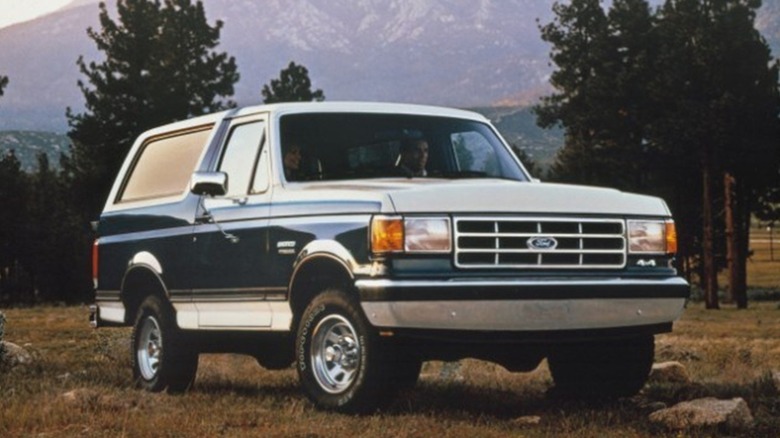What Are Bricknose Ford Trucks And Which Years Were They Made?
It's no secret that Americans love pickup trucks. Take the Ford F-150, for example — it ranks as the best-selling Ford vehicle of all time. With that many like-minded people surrounding a style of vehicle, nicknames begin to pop up, just like with the "Square Body" Chevy trucks from the 1970s and 1980s. While the Square Body spans two decades, the Bricknose moniker is more precise, only applying to one generation of Ford F-Series pickup trucks and a single generation of the full-size Bronco SUV.
Automakers use various naming methods to set trucks offering a special set of features apart, like F-150 vs. F-250 to show differences in payload and towing, XL vs XLT to denote trim levels, and even "Special Edition" trucks to entice regional buyers. Terms like Bullnose, Bricknose, and Aero Nose more often originate with the people describing the physical characteristics of different generations of Ford F-Series trucks and Broncos.
Bricknose Ford trucks include fourth-generation full-size Broncos and eighth-generation F-Series pickup trucks. Those generations span the same five model years from 1987 through 1991. The Bricknose name, as you might suspect, came from subtle changes to the front facia and grille with the changing of generations, namely the laid-brick-like pattern of the 12 rectangular openings in the grille stacked neatly in three rows and four columns.
What's special about Bricknose Ford trucks?
Everyone knows about the Muscle Car Era of the 1960s and very early 1972, and most recognize the Malaise Era that followed, stretching into the mid-1980s. The Bricknose Fords enjoyed the automotive-performance renaissance of the late 1980s, especially the addition of fuel injection. Before the Bricknose, Bullnose Fords (1980-1986) was powered by a lackluster, although hardy, 300-cubic-inch (4.9L) inline six-cylinder offering 117 horsepower and 223 lb-ft of torque. In 1987, Ford swapped out the 300's carburetor for fuel injection, and power ratings jumped to 145 horsepower, and torque increased to 265 pound-feet.
In addition to fuel-injected inline-six, Ford offered a selection of more powerful V8s as options on base models and standard on higher trims. Those V8 engines included the 302-cubic-inch (5.0L), 351 (5.8L) Windsor, 460-cubic-inch (7.5L) 385-Series big block, and 445-cubic-inch (6.9L) diesel. The largest displacement engines were only available on heavy-duty F-Series trucks, and 1988 would see the introduction of the 7.3-liter diesel.
Ford also incorporated previously option-only features like power steering, power brakes, and anti-lock rear brakes into its list of standard equipment with the new generation trucks in 1987. For 1991, the final Bricknose model year, Ford introduced the Nite Edition, essentially a blacked-out four-wheel drive XLT Lariat. The base engine was the 5.0-liter V8, or buyers could upgrade to the optional 351 Windsor.

